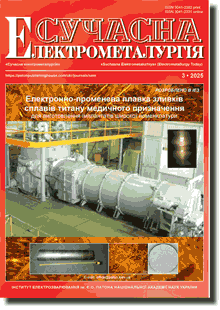| 2025 №03 (05) |
DOI of Article 10.37434/sem2025.03.06 |
2025 №03 (01) |

"Suchasna Elektrometallurgiya" (Electrometallurgy Today), 2025, #3, 64-70 pages
Investigations of ESR of AISI 304 stainless steel under different fluxes
M.M. Yamshynskyi1, M.S. Lavreniuk1, D.I. Trykozenko2
1National Technical University of Ukraine «Igor Sikorsky Kyiv Polytechnic Institute». 37 Prospect Beresteiskyi, 03056, Kyiv, Ukraine. E-mail: yamshinskiy@ukr.net2E.O. Paton Electric Welding Institute of the NAS of Ukraine 11 Kazymyr Malevych Str., 03150, Kyiv, Ukraine. Е-mail: dan2002@ ukr.net
Abstract
The process of electroslag remelting (ESR) of AISI 304 stainless steel under four different fluxes is considered. The remelting performance of the consumable electrode was determined for each flux at the same applied power. Changes in the slag chemical composition after consumable electrode remelting were analyzed. The size and quantity of non-metallic inclusions in the ingot metal after ESR under fluxes of different chemical compositions were investigated. It was established that choice of flux has a significant impact on the quality of the resulting ingots. The most effective flux among the studied compositions is recommended for ESR of AISI 304 stainless steel. The best indices of preservation of the steel chemical composition and the quantity of non-metallic inclusions in it were achieved in the ingot produced by ESR under ANF-7 flux. It had the lowest index of contamination by non-metallic inclusions and the smallest quantity of metal oxides in the slag after remelting. The metal of the ingot produced by ESR under ANF-1 flux also showed good results by the index of contamination by the non-metallic inclusions. However, remelting under this flux influenced Si and Mn content in the metal to the greatest extent. 8 Ref., 5 Tabl., 3 Fig.
Keywords: electroslag remelting; consumable electrode, stainless steel, slag, flux, filling coefficient, remelting productivity, non-metallic inclusions, chemical composition, ingot
Received: 01.06.2025
Received in revised form: 30.07.2025
Accepted: 07.08.2025
References
1. Paton, B.E., Lipinsky, V.A. (1973) Electroslag remelting: Theory and practice. Kyiv, Naukova Dumka.2. Isaenko, V.P. (1992) Technology of electroslag remelting of steels. Kyiv, PWI.
3. Kurylo, P.Ya. (2007) Electroslag remelting: Textbook. Lviv, Lviv Polytechnic Publishing House.
4. Novikov, I.I., Zhukov, V.I. (1983) Metallurgy of welding production. Moscow, Mashinostroenie.
5. Pedchenko, Ye., Kostetsky, Yu., Polishko, G. et al. (2023) Recycling of steel using the ESR method in the conditions of limited resources of raw materials to preserve the chemical composition and properties. In: Proc. of Inter. Young Scientists Conf. on Modern Problems of Materials Science, 27-29 September, 2023, Lviv. https://doi.org/10.15407/msse2023.047
6. Pedchenko, Ye.O., Kostetsky, Yu.V., Petrenko, V.L., Medovar, L.B. (2022) Recycling of used non-compact highspeed steel tools by electroslag remelting. Suchasna Elekrometalyrhiya, 3, 23-28 [in Ukrainian]. https://doi.org/10.37434/sem2022.03
7. Pedchenko, Ye., Medovar, L., Kostetsky, Yu., Petrenko, V. (2022) Electroslag remelting as a method of recycling non-compact high-speed steel tools. In: Proc. of 31st Inter. Conf. on Metallurgy and Materials), 18-19.05.2022, Brno. https://doi.org/10.37904/metal.2022.4455
8. DSTU ISO 4967:2017: Steel. Determination of non-metallic inclusions. Microscopic examination method
Advertising in this issue:
To order the electronic version of the paper:
M.M. Yamshynskyi, M.S. Lavreniuk, D.I. TrykozenkoInvestigations of ESR of AISI 304 stainless steel under different fluxes
Electrometallurgy Today №03 2025 p.64-70
The cost of article (pdf): 13 $, 12 €, 150 UAH (1 copy. )
fill in the form below:
The cost of subscription/purchase order journals or individual articles
| Journal/Currency | Annual Set | 1 issue printed |
1 issue |
one article |
| TPWJ/USD | 384 $ | 32 $ | 26 $ | 13 $ |
| TPWJ/EUR | 348 € | 29 € | 24 € | 12 € |
| TPWJ/UAH | 7200 UAH | 600 UAH | 600 UAH | 280 UAH |
| AS/UAH | 1800 UAH | 300 UAH | 300 UAH | 150 UAH |
| AS/USD | 192 $ | 32 $ | 26 $ | 13 $ |
| AS/EUR | 180 € | 30 € | 25 € | 12 € |
| SEM/UAH | 1200 UAH | 300 UAH | 300 UAH | 150 UAH |
| SEM/USD | 128 $ | 32 $ | 26 $ | 13 $ |
| SEM/EUR | 120 € | 30 € | 25 € | 12 € |
| TDNK/UAH | 1200 UAH | 300 UAH | 300 UAH | 150 UAH |
| TDNK/USD | 128 $ | 32 $ | 26 $ | 13 $ |
| TDNK/EUR | 120 € | 30 € | 25 € | 15 € |
AS = «Automatic Welding» - 6 issues per year;
TPWJ = «PATON WELDING JOURNAL» - 12 issues per year;
SEM = «Electrometallurgy Today» - 4 issues per year;
TDNK = «Technical Diagnostics and Non-Destructive Testing» - 4 issues per year.









